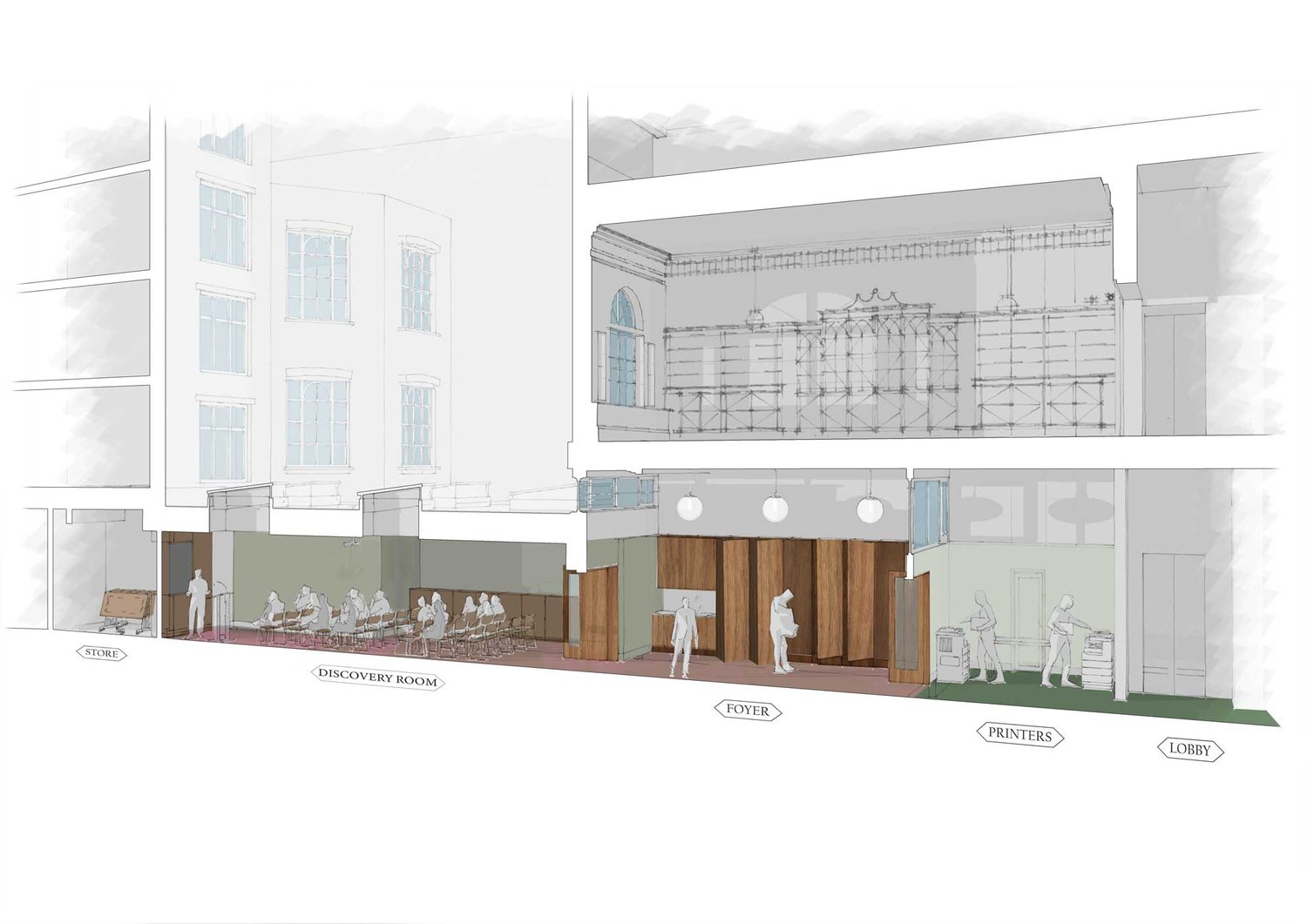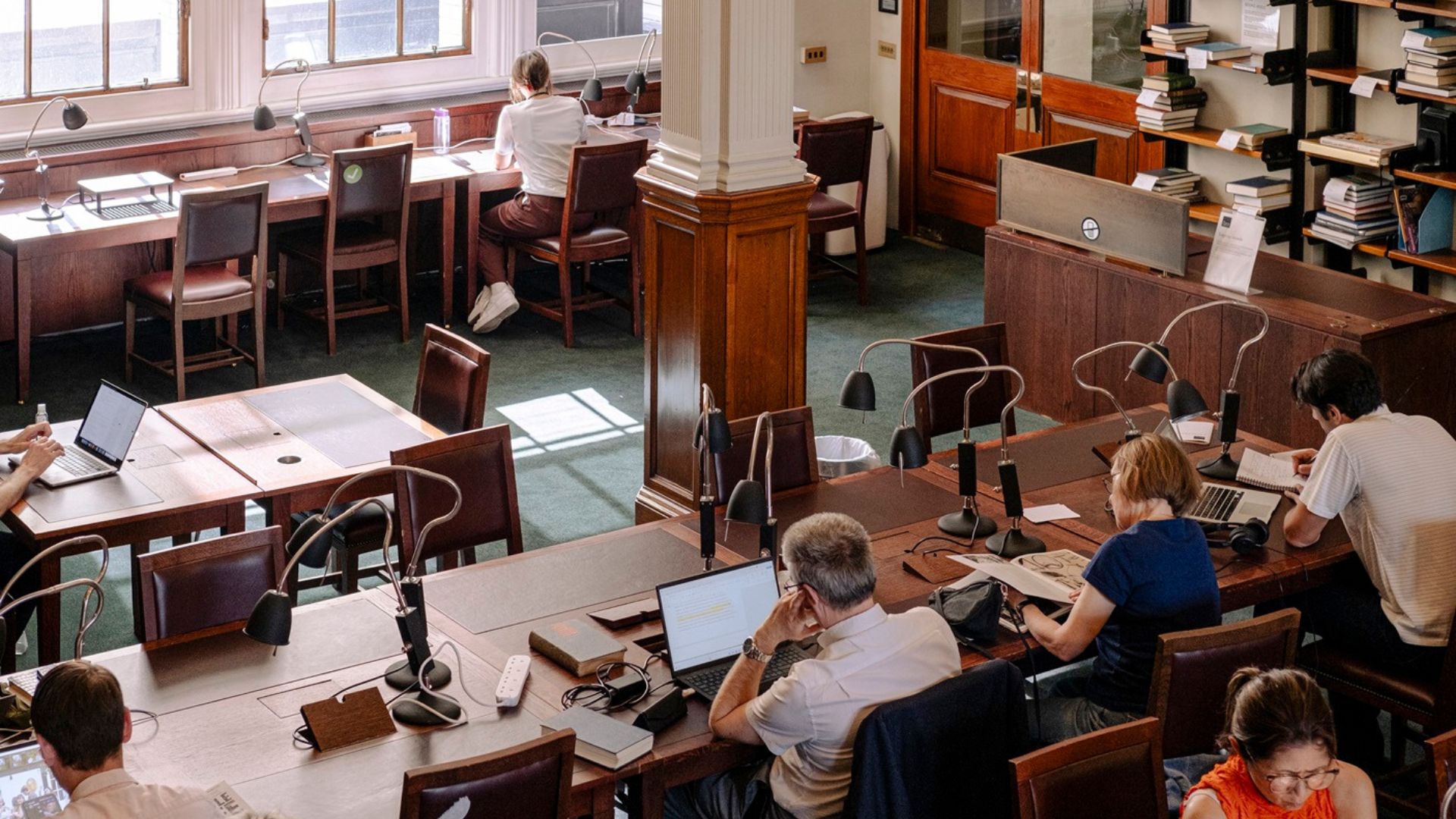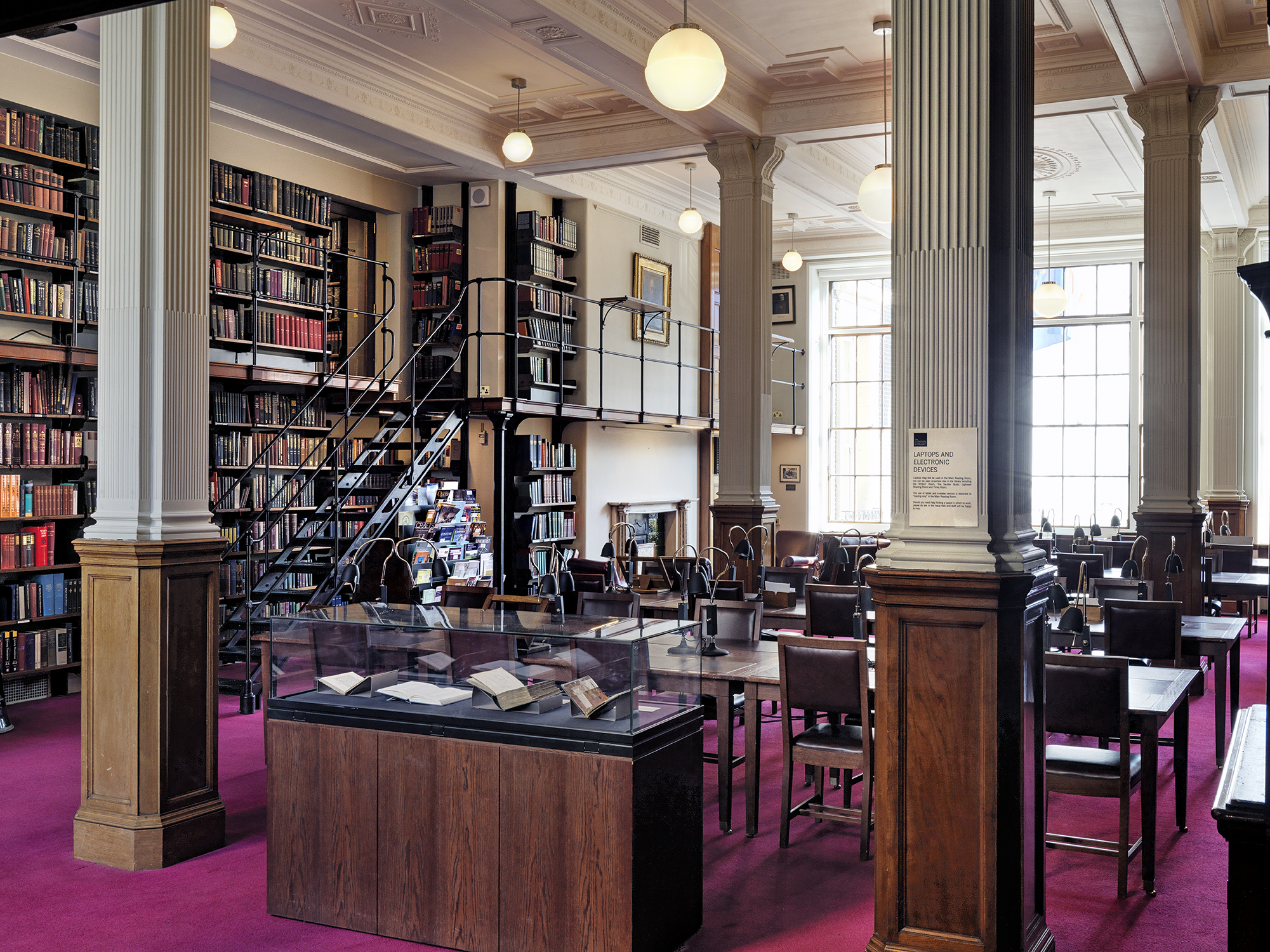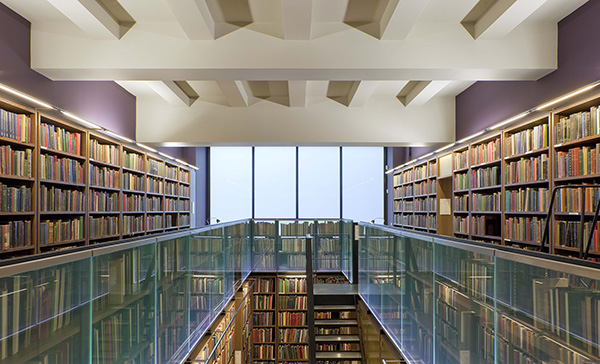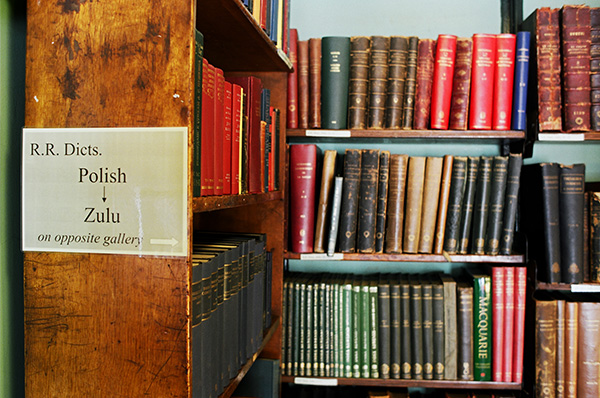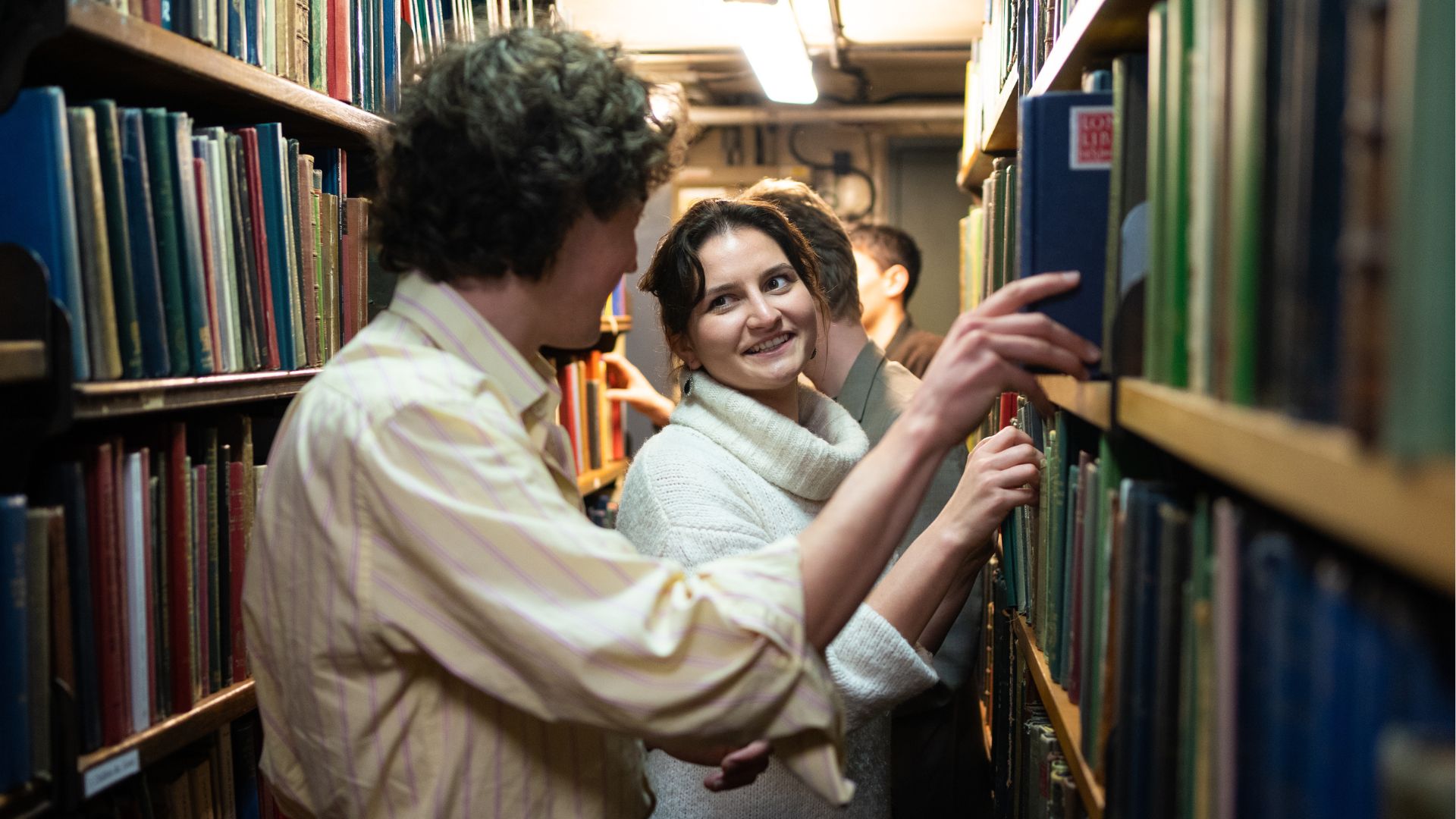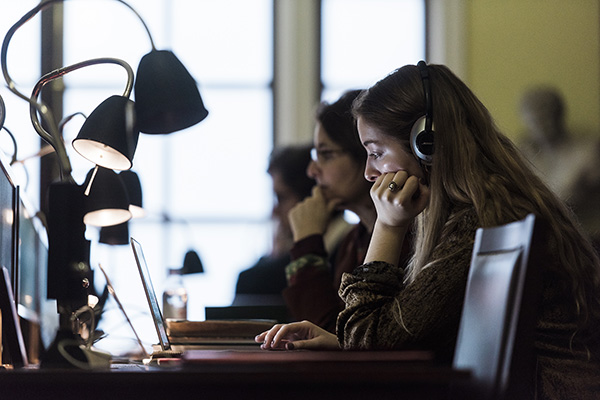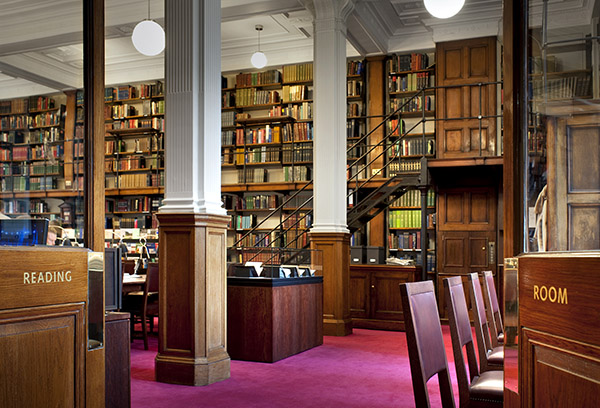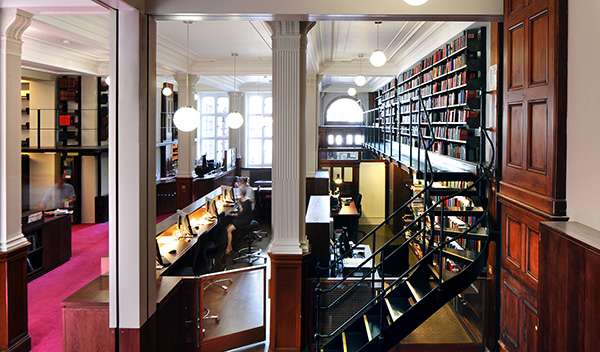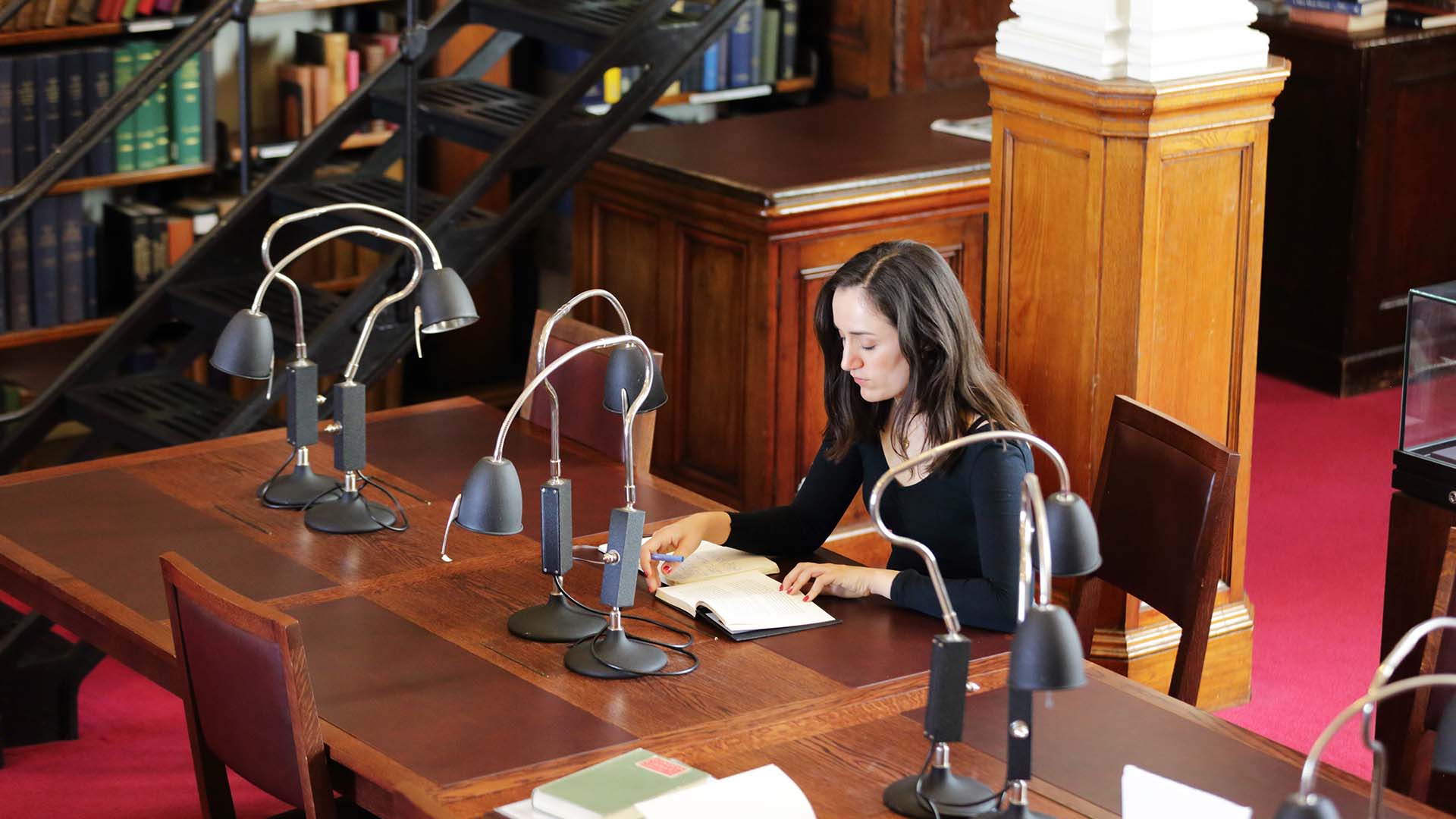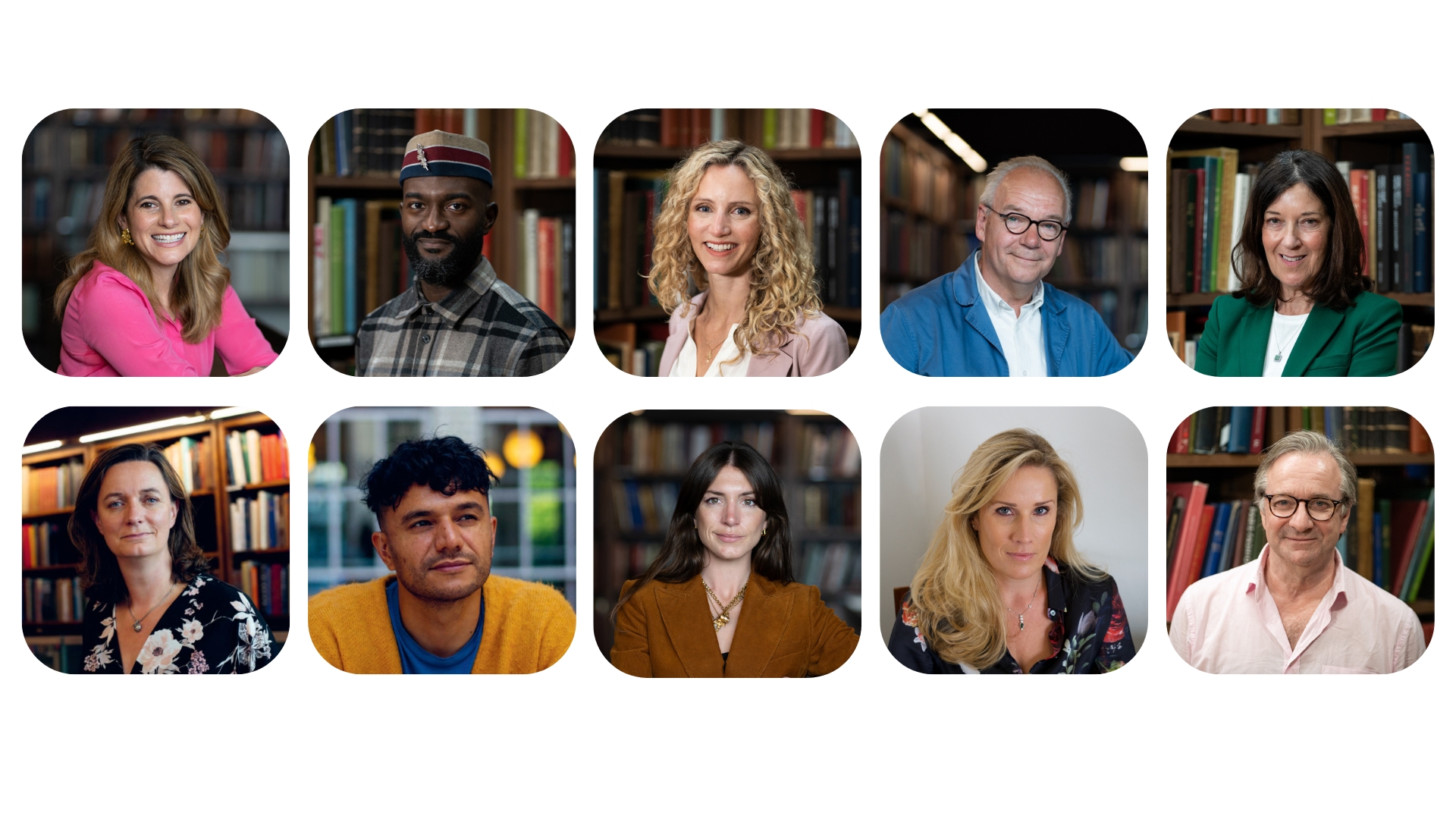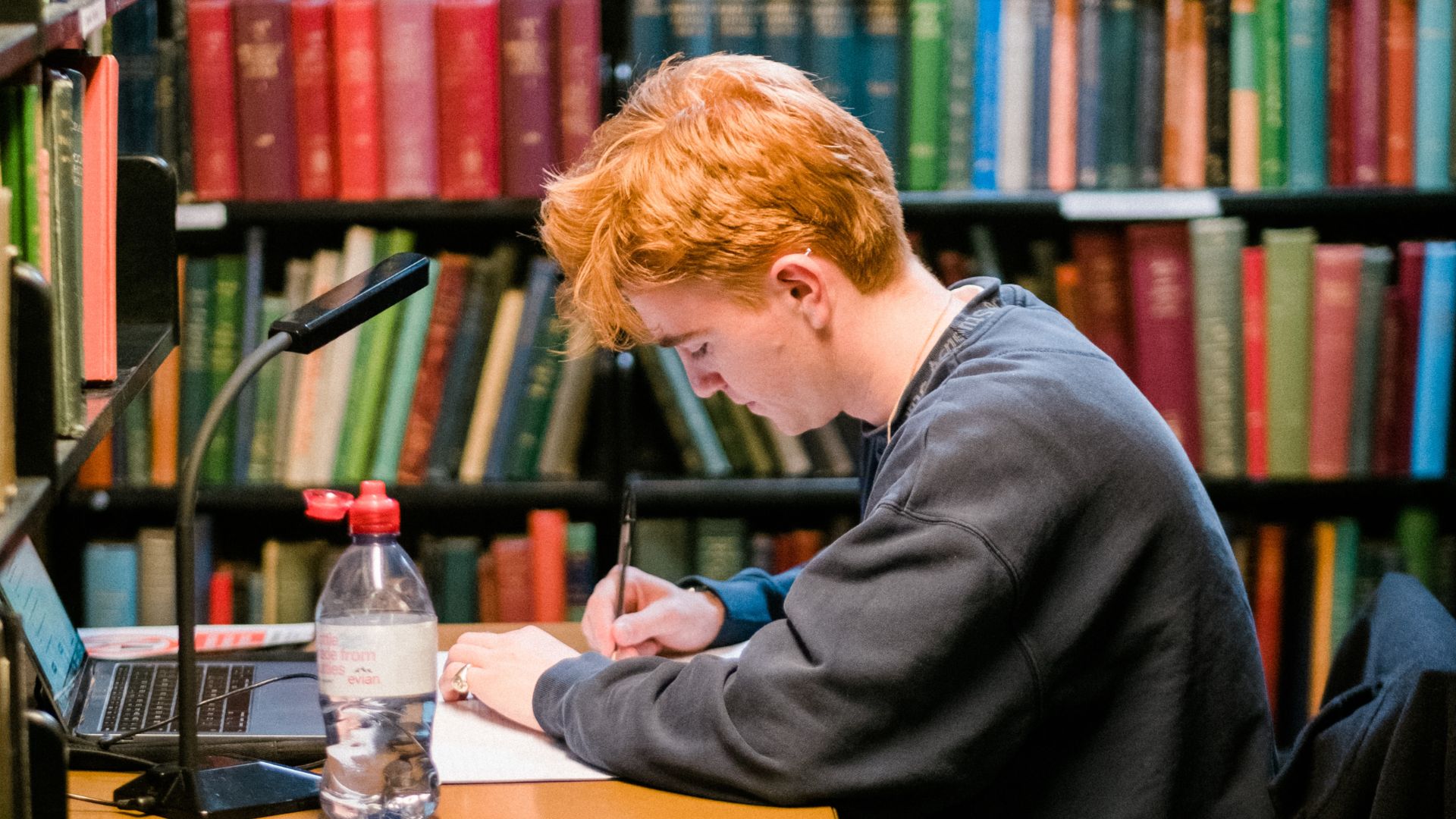The London Library AGM | 25 November 2025
Director of Collections and Library Services Speech Notes
Building Connections: Phase One Building Works Update
Our Phase One building works commence this summer and will be complete at the end of December 2025.
Specific arrangements for the duration of the building works are detailed below, followed by the dates when members may experience potential disruptions. We will aim to keep any inconvenience to a minimum.
Please check this webpage for updates before you visit the Library.
Our building improvements are intended to help us make our collection more accessible, support the needs of our growing membership, and ensure our long-term sustainability. We are funding the improvements entirely from donations, and the funds for Phase One have already been secured.
Visit the project website for more information and detailed FAQs. If you have any further questions or comments, please write to us at This email address is being protected from spambots. You need JavaScript enabled to view it..
Key Dates (November update)
While we will aim to keep any inconvenience to a minimum, there may be some disruption on the following dates.
8 - 12 December: Intermittent noise throughout the week due to mechanical and electrical containment being installed in the kitchen and The New Room. On Tuesday and Wednesday, the upper back basement will be closed to members as electrical supplies will be pulled through.
1 - 5 December: Intermittent noise throughout the week due to new internal partitions being installed in the foyer and new kitchen.
24 - 28 November: Intermittent noise as a result of installation of ductwork in the ground floor and basement areas. From Wednesday - Friday, there will be noisy works due to cutting out floor boxes in the New Room.
17 - 21 November: Intermittent drilling due to ductwork in the basement being installed. The upper back basement will be closed from Monday - Wednesday to fit running water and heating supplies in the New Room.
10 – 14 November: Excessive noise disruption expected to continue until Wednesday due to intermittent drilling into the floor from the front basement. From Wednesday to Friday, disruption expected due to intermittent drilling into a wall to create a vent in the front of the building and the upper back basement will be closed to members. For book retrievals, please ask a member of staff on the Issue Hall desk.
3 – 7 November: Noise disruption expected in the Issue Hall due to knocking down walls in the New Room and intermittent drilling into the floor from the New Room to below the back basement. From Thursday – Friday, excessive noise is expected around the Library and the basement Back Stacks will be closed to members to install pipes across the ceiling connecting the new WC's in the New Room.
20 October - 31 October: Intermittent noise disruption expected due to installing and soundproofing the ceiling in the New Room.
13 October: Intermittent drilling coming from The New Room in the earlier part of this week. From Thursday till Friday, we expect there to be noise disruption from knocking down part of a wall in The New Room.
8 - 10 October: Intermittent noise disruption expected in the Library while we plaster and insulate the ceiling of the New Room. We expect that large parts of the Library will remain unaffected by the noise.
10 October: Back basement closure for ongoing building works.
18 August - 12 September: Noise disruption expected in the Issue Hall and front basement until approximately 3pm while back-office walls are broken down.
4 August - 18 August: Preparation works commence with noise disruption expected in the Issue Hall while hoardings are installed and roller racking from part of the front basement (the area directly below the Issue Hall) is removed. The basement toilets will remain fully accessible. There will be no access to the collections in the front basement and requests for volumes in this area must be made 2 working days in advance.
24 July: Catalogue Hall (area beyond the ground floor lift) will be closed. Equipment (printer, scanner, catalogue computers) and guard books in the area will be moved to new locations.
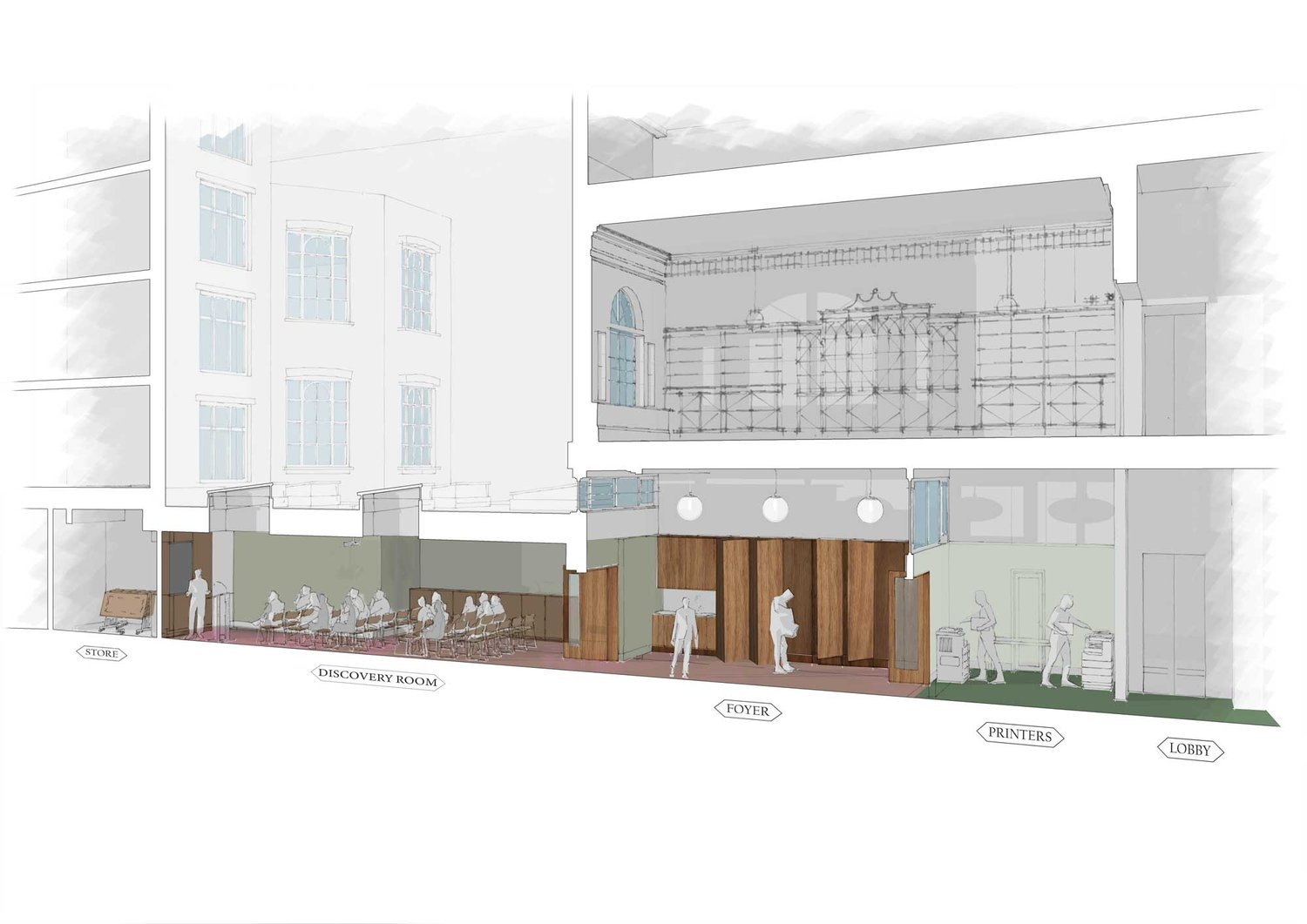
The works will commence in the week commencing 4 August 2025, enabling us to take advantage of the quieter period in the Library over summer and keep any inconvenience to a minimum.
The front part of the basement (the area directly below the Issue Hall) will be closed to members for the duration of the works. Access to volumes in this area will therefore be restricted and members must request volumes for retrieval 48 working hours in advance via Catalyst. There will be no on-the-spot retrievals or retrieval on weekends. Staff will have access to this area for retrieval once per day. The basement toilets will remain fully accessible.
The area beyond the ground floor lift containing the printer, scanner, catalogue computers and guard books will also be closed. Members will continue to have access to these services throughout the works as the equipment and books will be moved to the new locations listed below. These moves will commence in the week commencing 21 July 2025.
PCs: 1 to the Issue Hall
2 to the Foyle Lightwell
1 to the Back Stacks basement
1 to the Central Stacks (Floors 4)
1 to the Stoppard Room
Overhead book scanner: Foyle Lightwell
Photocopier& printer: Issue Hall
Preparation works commence on 4 August with noise disruption expected in the Issue Hall from 18 August for at least two weeks while hoardings are installed and roller racking from part of the front basement is removed.
Societies is now fully accessible for members. The location of Societies is now as follows:
A - British Oological Society - outside the Foyle Lightwell Reading Room
British Record Society - Z - Upper Basement
Annuals – all
Philology – all
Periodicals octavo – Fortnightly Review, previously split between the Lightwell and Front Basement, has now been reunited and is located outside the Lightwell. As a result, Periodicals octavo from Forum to Z will be inaccessible from next week. These titles have been labelled accordingly, and members are asked to request volumes 48 working hours in advance.
The building works should be complete at the end of December 2025, with the room ready for use in February or March 2026.
We expect that the rest of the Library will remain unaffected by the Phase One building works.
Our building improvements are intended to help us make our collection more accessible, support the needs of our growing membership, and ensure our long-term sustainability. We are funding the improvements entirely from donations, and the funds for Phase One have already been secured.
If you would like to read more about the project, please visit the project website where you will also find detailed FAQs. If you have any further questions or comments, please get in touch with us at This email address is being protected from spambots. You need JavaScript enabled to view it..
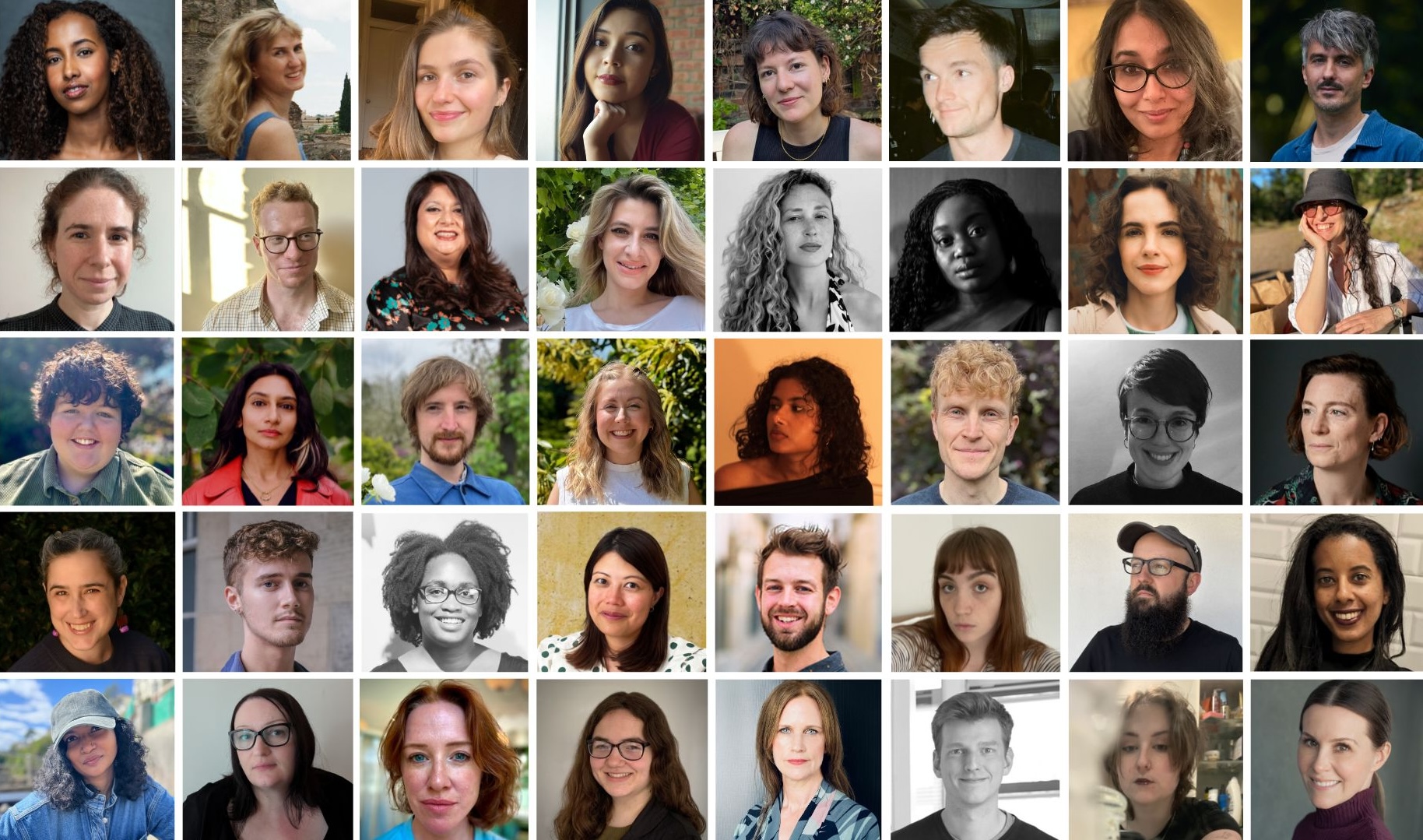
Meet the 2025/26 Cohort of the Emerging Writers Programme
The London Library is delighted to announce the newest cohort of its flagship Emerging Writers Programme, which supports early-career writers and is now entering its seventh year. The Programme is made possible thanks to the vital support from Amazon Literary Partnership, Bloomsbury Publishing, The Charlotte Aitken Trust, and Hawthornden Foundation.
40 participants were selected anonymously from a field of over 1950 applicants, a record-breaking number, by a panel of judges including poet Rishi Dastidar (Neptune’s Projects, Too Young, Too Loud, Too Different); children’s author, novelist, scriptwriter and songwriter Maz Evans (Who Let the Gods Out, Vi Spy); novelist and short story writer Irenosen Okojie(Nudibranch, Curandera); non-fiction author, photographer and broadcaster Johny Pitts (Afropean, Home is Not a Place); screenwriter and director Benjamin Ross (The Young Poisoner’s Handbook, Poppy Shakespeare); playwright and performer Chris Thorpe (The Shape of Pain, A Family Business) and C&W literary agents Emma Finn and Lucy Luck.
The emerging writers hail from across the UK, from Scotland to the South Coast, Northern Ireland to Cambridgeshire and they span an age range from early twenties to early fifties. The cohort is working on a diverse array of projects, taking us from Sri Lanka to Zimbabwe, the Philippines to the Caribbean, the borderlands of Poland/Ukraine and England/Scotland and to all the many global iterations of Lands End. They explore ancient Rome, the Silk Road, Victorian erotica, Cold War Germany and the Partition of India. There are projects about literary couples, divorce, eugenics, sonic distortion and sonic fetishism, nostalgia, grief, religion and romance.
Of the 40 writers, seven are working on non-fiction and memoir, eighteen are writing novels, four of which are for children or young adults, seven are writing for stage/screen - including one comedy musical, four are poets and four are writing short stories.
The London Library’s Emerging Writers Programme is geared towards supporting writers who have not yet published a full-length work of fiction, non-fiction, collection of poems, or had a full-length work professionally produced for stage/screen. The 2025/26 Programme will run from 1 July 2025 to 30 June 2026.
Participants benefit from one year’s free membership of The London Library alongside a programme of writing development and networking opportunities, peer support, and guidance. Membership to The London Library includes: access to its collection of around one million books and periodicals (almost all of which can be borrowed), a vast eLibrary, atmospheric workspaces in a beautiful building, a members’ suite, nationwide postal loans, and discounted tickets to the Library’s popular public events programme. The cohort will be following in the footsteps of the many writers, readers and thinkers who have made the Library their home for over 180 years.
About The Emerging Writers Programme
The Library’s Emerging Writers Programme is open to anyone who is committed to pursuing a career in writing (for publication or performance), wants to develop their work and is working on, or planning, a specific project which will make extensive use of the Library’s resources and is intended for publication or production.
The London Library Emerging Writers Programme is only possible because of the generous support the Library has received from Amazon Literary Partnership, Bloomsbury Publishing, The Charlotte Aitken Trust, Sir Max Hastings, Hawthornden Foundation, The Jerzy Peterkiewicz Educational Foundation, John & Kiendl Gordon, The Paragon Trust, Robert MacLeod, and other anonymous donors.
Two bursary funds are available to support members of the cohort who may face financial, health, or any other barriers that would prevent them fully accessing the Programme. The Emerging Writers Programme Access Bursary has been generously funded by the International Friends of The London Library to help support those participants most in need and the Virago Participation Bursary has been generously funded to support Black women and Black writers from under-represented genders.
Meet the 2025/26 cohort:
Michael Athey is a Northumbrian poet. He holds an MA in Creative Writing from UEA and was awarded Runner Up in the 2024 Young Norwich Creative Awards. His work features in BlackIris Poetry and PulpPoetsPress. Away from writing he works with young people in a charity role.
@m_athey505
Jenny Barker is a teacher and writer from Bradford. She recently completed her MA on the Creative Writing pathway of the Children’s Literature programme at Goldsmiths University. Based in London, she is currently working on a YA verse novel exploring grief and identity.
IG: @jennybwrites
Settit Beyene is a polyglot from London who works in Fintech. She has worked in schools, summer camps and hostels across Italy, Spain, Portugal and Brazil. She’s working on her second novel.
Alexandra Boulton is an actor and writer, based in London, with a love for offbeat comedy-drama. Part-Turkish, she moved to England aged 8. She speaks French and learned fluent Mandarin at Cambridge University. With credits across screen, audio, and improv comedy, she spends her spare time playing Dungeons & Dragons.
IG: @alexandra_boulton | BS: @alexandraboulton.bsky.social
Jon Buckland lives on the South coast and writes about music for a living. Primarily for The Quietus, Resident Music, and Bandcamp Daily, but you can also find his work at State51, Greedmag, Boulderdash Zine, and in many other publications. He is currently working on a book about distortion.
IG&BS: @PacificBeliefs
Sarah Cotton writes fiction which blurs the lines between the psychological and the unreal. In 2024 she received a Spread the Word Early Career Bursary and was longlisted and shortlisted for the Commonwealth and Bridport short story prizes. Her novel follows sisters navigating shifting power balances under patriarchal social systems.
X: @Sarah_Cotton | BS: @sarah-cotton.bsky.social
Katharine Crandon is a psychotherapist and doctor. She is a graduate of the Curtis Brown Creative and Faber Academy novel writing courses. Katharine studied philosophy and medicine at Oxford University. She is working on a memoir about madness and murder, and a novel. She lives in Oxfordshire and has six children.
IG: @katharine_crandon | SS: katharinecrandon.substack.com
John Dinneen is a British-Irish writer. His plays have been longlisted for the Bruntwood (2025), BOLD (2024) and Alternarratives (2020). He hopes to tell stories that unite audiences in a world that seems increasingly designed and determined to divide us.
X: JJinneen | IG:kickitanywhere
Caroline Druitt is a writer and facilitator, running workshops across London in unlikely places. Her poems have been shortlisted for the Bridport Prize, Aesthetica Creative Writing Award and commended in the National Poetry Competition. She is working on a poetry collection and a piece of life writing, ‘Harmos’ exploring chronic illness.
@carolinedruitt
Sarah Currie Dyer searches for stories where history, nature, and empathy intersect. Raised in America, England has been her home for over a decade where she now lives in Bath. After twelve years teaching middle school, Sarah graduated from Bath Spa University’s Masters in Writing for Young People with distinction.
IG: @sarahcurriedyer | BS: @sarahcurriedyer.bsky.social
Anne Elicaño-Shields is a Filipino writer and international development professional. She is the inaugural winner of the Political Short Story Award (Word Factory), a Future Worlds Prize finalist, and has performed at the London Literature Festival (Southbank Centre). She is writing her second novel, a decolonized retelling of a 19th century Filipino epic poem.
IG: @lavieannerose
Killian Faith-Kelly writes journalism and short stories. He’s had writing published in GQ, The Fence, The Londoner, New Critique, Press Gazette, The i, the Radio Times, Men’s Health and a few others. He’s originally from County Derry but now lives in London.
X: @killianDelly |IG: k_faith_k
Zoey Forbes is a literary lawyer and writer from the Midlands. Her interdisciplinary work explores the legal and ethical implications of artistic creation. She is currently working on a non-fiction book about literary and artistic couples and the invisible labour that make great art possible. She lives in London.
X: @zoeyforbes | IG: @zoeyforbes
Shaniqua Harris is a Bajan Brit. She graduated with an MA in Creative Writing from Birkbeck, where she was awarded the Kit de Waal Scholarship. Her work is focused on women, plantations, islands, and the Caribbeanness of it all. She is pursuing a PhD and writing her first novel.
@shaniqua_harris
Roua Horanieh is a Syrian British writer and overseas qualified architect. She lives in London with her husband and daughter. Roua’s plays, essays, stories and art installations sit at the intersection of architecture and storytelling. Her work often focuses on displacement with a participatory approach and collective creative practice.
IG: rouahoranieh | X: roua_ho
Holly Jeffrey is a trainee clinical psychologist and writer of historical fiction. She is currently working on her debut novel set in Ancient Rome.
Holly Jessop is a London based designer and aspiring writer. She has been recognised in a few competitions including the Wilbur Smith Adventure Writer of Tomorrow (commendation) and Searchlight Award for Best Novel Opening for Children or Young Adults (winner). She draws inspiration from folklore, mystery and historical fiction.
Nathaniel Jones (he/they) is a screenwriter and playwright from Manchester, currently working in theatre production. Their work includes a solo folk musical about hidden history, Sing, River (Pleasance Courtyard) and a sitcom-style comedy play about a timeless friendship Philos & Amica Do Time (Riverside Studios).
IG: @nathanielhjones
Hannah Kennedy is an award-winning writer for stage, screen, audio and immersive media from Buckinghamshire. Hannah is an alum of 4Screenwriting and the Jed Mercurio Mentorship Programme. Their work has been recognised by the RSC’s 37 Plays Project, the Nancy Dean Lesbian Playwriting Award and the BAFTA Rocliffe Competition.
IG&BS: @hannahkennedy.uk |X: @hckennedy_ |www.hannahkennedy.uk
Pete Kowalczyk is a writer from the north of England, with Polish and Ukrainian roots, living in Epping Forest. He's written for the Guardian, the European Review of Books, and Tolka among others, and was shortlisted for the 2023 Fitzcarraldo Editions Essay Prize.
IG: @pete.kowalczyk
Shayna Kowalczyk is a poet and writer from London. Her work has been published in bath magg, Propel Magazine, berlin lit, the Interpreter’s House and elsewhere. She was a member of the Roundhouse Collective 22/23 and is a current trustee at Apples and Snakes.
Jonny Lennard is a Newcastle born film editor now living in the South East. He is currently working on a novel about masculinity, language and folklore set in Northumberland.
Janice Mamukwa is a Zimbabwean writer. She has an MSt in Creative Writing from Oxford and is completing a PGCert in Teaching Creative Writing at Cambridge. Her work explores racial boundaries, the Black female body, mother-daughter relationships and self-image, and the immigrant experience. She is currently working on a novel.
@JMamukwa
Kirsty Mann writes comedy. Her first show, Skeletons, started at the Edinburgh Fringe before transferring to Adelaide Fringe (Winner Best Weekly Comedy), Fringe World (Winner Best Overall Comedy), Melbourne International Comedy Festival and Soho Theatre. Her short film, Lady Brently’s End, was a hit on the film festival circuit.
IG&TT: @kurdymann | YT: @KIRSTYMANN
Ishita Marwah is a writer, fiction editor, physician, and scientist. Her book-in-progress frames the lifework of Francis Galton, the founder of eugenics, in her own experiences of marginalisation. Ishita is also working on a novel about decolonisation, dating, and diaspora desis. She is chronically ill and neurodivergent.
X: @IshitaMarwah
Hadsan Mohamud is a British-Somali actor and writer from NW London. With a degree in Psychology, her work primarily explores themes of mental health, identity and belonging. She recently had a sold-out reading of her play, Keep Moving Forward at Omnibus Theatre and is developing her new play Crush as part of Soho Theatre Writer’s Lab.
IG: @hadsanmohamud | X: @hadsanmohamud
Farah Najib is an award-winning playwright whose work frequently explores female rage, community, and bodily experience through a darkly humorous lens. She is an alumna of the Royal Court Writer's Group, Soho Theatre Writer's Lab and the Royal Central School of Speech & Drama. Her play Maggots will be staged at the Bush Theatre’s studio space in February 2026.
IG: farah_najib_ | X: @ohheyfarah
Victoria Pearce is a writer from South London. She has degrees in Literature and Political Theory from Oxford University and Birkbeck College. A former teacher, she is currently undertaking an AHRC-funded doctorate at Bristol University and writing her first novel, an account of the founding of the first domestic violence refuge in 1970s London.
Isabella Peralta is a writer, editor, and educator whose work explores identity, mental health, belonging and love. She holds an MSt in Creative Writing (Distinction) from the University of Cambridge and is an alumna of Faber Academy and the HarperCollins Author Academy. Her writing has been listed for the Lucy Cavendish Fiction Prize and the 4thWrite Prize.
IG: @isabellaperalta
Pádhraic Quinn is an Irish writer based in London. He recently completed an MA in Creative Writing at The University of Hull. His writing has been published by The Irish Independent, Reflex Press, and can also be found in Catalan with Vallesos. He is currently working on his debut novel.
BS: @quinnpadhraic.bsky.social
Hannah Rosefield is a writer and editor from London. She has lived in Boston and Atlanta and has a PhD in Victorian literature from Harvard University. Now an editor at The Dial magazine, she also writes about fiction and social and cultural history.
BS: @hannahrosefield.bsky.social
Meara Sharma is a writer whose work has appeared in The Believer, Frieze, Vogue, Apartamento, Ambit, and elsewhere. She also edits Elastic, a magazine of psychedelic art, and produces film and radio. A 2025 Hawthornden Fellow, she is working on a nonfiction project about peripheries as well as two novels.
IG&X: @mearasharma |www.mearasharma.com
Eve Smith is a writer, artist and recent graduate based in Cambridge. At university, she was Editor in Chief of Trinity Film Review and shortlisted for the Irish Student Media Awards. She is working on her debut novel, set on the Antrim coast, about adjusting to physical difference, hope and what it means to be acutely aware of the inherent precarity of life.
@e.veschmeve
Aparna Surendra is a Sri Lankan writer based in London. Her fiction has been shortlisted for the White Review Short Story prize and Wasafiri New Writing Prize. She is a 2025 Tin House resident and previous recipient of the London Writers Award. Aparna writes fiction alongside a career in digital rights.
X: aparna_s1
Rebecca Veii is a Creative Director and writer based near Cambridge. Her debut novel explores the darker impulses behind musical genius, colliding classical tradition with underground audio culture and sonic fetishism. Longlisted for the Bridport First Novel Prize, she is a graduate of Curtis Brown Creative’s flagship novel-writing course.
Teddy Webb is a poet, essayist and graphic designer. Her work, which focuses on themes of lesbian culture and reclaiming connection to the natural world under capitalism, has been published in The Seaford Review, Writer’s Hour Magazine and Butch-Femme Press. She is working on her first pamphlet. She lives in Brighton with her girlfriend and their cat Goose.
IG: @soundssofwords
George Wigzell is a writer and actor from Leeds. His training includes Arvon’s Writing for Young Adults and Faber Academy’s Writing a Novel courses. His acting credits include Bridgerton and The Witcher and extensive stage work for young audiences. He likes baking bread, playing boardgames and obsessing over Leeds United.
IG: @georgewigzell
Sabrina Wolfe is a writer living in Southeast London. They have had short stories placed in a number of competitions, including the Edinburgh Short Story Awards and Harper’s Bazaar story competition. They are working on a short story collection and writing a novel about queer desire, nostalgia and second chances.
@wolvesinlondon
Kate Wyver is a freelance theatre critic and features writer published in The Guardian, The Stage, The Independent and Financial Times. She reads and writes queer stories.
@katewyver
Tahira Yaqoob is a journalist from London and a recent graduate of the MA Creative Writing at UEA, where she was the recipient of the Kowitz Scholarship and joint winner of the Curtis Brown Award. She was a 2024/5 Curtis Brown Breakthrough writer. Tahira is working on a fiction novel and writes about race, identity, migration and dislocation.
Our Charitable Object, Mission, Values and 5 Year Strategic Plan
Charitable Object
The advancement of education, learning and knowledge by the provision and maintenance in London of a library embracing the arts and humanities for all persons desiring to make bona fide use thereof for the said charitable object subject only to the payment of such sums (if any) by way of fees and other charges as are necessary to defray the expenses of the provision and maintenance thereof.
Mission
To inspire, support and promote the creation and sharing of knowledge and ideas through reading, writing and discussion.
Vision to 2030
To establish the Library as “The Home of Literary Inspiration.” We want to be widely recognised as a welcoming, accessible, inspiring, and supportive place for the creation, discovery and enjoyment of literature. We want to further develop our collection, continue to grow our reach and impact, and consolidate our financial sustainability.
Values
We are:
- Inspiring – enthusiastic about sharing knowledge and inspiring and supporting the interests and creativity of others
- Independent – unique, free to think differently and encourage freedom of thought and expression in others
- Welcoming – open, accessible, inclusive, friendly, helpful, supportive, and collaborative
- Excellent – striving for excellence, efficiency and impact in all that we do.
5 Year Strategic Plan (2025-2030) “The Home of Literary Inspiration”
The London Library was founded to share knowledge and inspire the creation of new ideas. Over the last 184 years, it has inspired and supported writers, thinkers, scholars and artists in the creation of some of the world’s most famous books, scripts and ideas that have, in turn, touched the lives of many millions, shaping the intellectual history of the nation and the world.
Just as importantly, the Library has facilitated the personal creativity and intellectual journeys of many tens of thousands of individuals who have benefited from the Library’s rich and uniquely accessible collection, conducive spaces to ready and study, and knowledgeable staff.
Turning to the future, our focus for the next 5 years is to establish the Library as “The Home of Literary Inspiration.” We want to be widely recognised as a welcoming, accessible, inspiring, and supportive place for the creation, discovery and enjoyment of literature. We want to further develop our collection, continue to grow our reach and impact, and consolidate our financial sustainability. To help us achieve these aims, we have set ourselves 7 strategic objectives:
1. Our Collection
To curate, conserve and celebrate a relevant, high-quality, culturally representative and uniquely accessible collection, appropriately balanced between physical books and digital holdings.
We will increase our investment in content across our combined print and digital holdings, delivering new acquisitions that are more responsive to member demand, and are more culturally representative, as well as extending the collections into new areas of interest. This will be supported by the new team of subject-specialist content librarians.
We will develop and deliver new initiatives to promote and celebrate the collection, and we will also increase our efforts to conserve and safely accommodate our expanding collection, including the digitisation of specific elements and the increased use of off-site storage.
2. Our Services and Systems
To provide a high-quality, welcoming and professional service to all, facilitating and enhancing their use, engagement with, and enjoyment of the Library.
We will review and improve systems for the delivery of all aspects of customer service and user experience. This will include the services we provide for members in relation to the collection as well as our services relating to membership joining, induction, renewal, communications and account management.
3. Our Building
To provide an inspiring, welcoming space for literary discovery, creativity and enjoyment.
We will deliver our Building Connections project and continue to improve our existing reading rooms and study spaces, enabling better access to the Library, providing greater opportunities for members to engage with the collection and each other, and ensuring that our facilities for study and refreshment meet members’ needs and expectations.
4. Our Programmes
To extend our programme of events and learning and participation activities, raising awareness, widening access and delivering inspiring, engaging and impactful events.
We will deliver high-quality programmes that celebrate the collection, the Library’s membership (past and present), and provide the opportunity to build connections and community.
We will develop our network of partners, consolidate the success of our Emerging Writers Programme, and extend our events programmes by including more member-focussed events, more digital access and establishing our biennial LitFest as a regular fixture. At the heart of achieving this will be the opening and programming of the new event space.
5. Our Profile
To increase the public awareness and recognition of the Library, especially as the “Home of Literary Inspiration”.
We will produce and deliver a new Membership Growth Strategy, setting out the detailed activities we will undertake to grow our membership base and support our fundraising efforts. We will leverage the profile-raising opportunities provided by our major projects such as “Building Connections”, LitFest, and the Emerging Writers Programme, and make increased use of our ambassadors and advocates for PR opportunities.
6. Our Finances and Fundraising
To consolidate our financial sustainability by growing income from membership, revenue fundraising and other sources, while also raising the capital funds needed to invest in Building Connections.
We aim to grow our membership to 8,500 and deliver an annual operating surplus of c£300k, equivalent to roughly 5% of our operating costs, by 2030. We will effectively articulate the Library’s charitable impact and make a compelling case for support from individuals and grant-making bodies.
7. Our People
To attract, develop and retain the best possible staff and volunteers that we need to deliver our goals, and to ensure that the Library is a welcoming and inclusive place to work and that we live our values.
We will produce and implement a Training and Development Strategy, investing in training at all levels. We will also carry out annual reviews of remuneration and benefits to ensure the Library is fair and competitive against benchmarked comparators.
We will explore the potential for increasing the use of volunteers in the Library.
This plan builds on the success of our previous 6 year plan and continues that approach, including the delivery of the major building project that was previously envisaged but not commenced in earnest.
We recognise that the targets we have set ourselves are challenging. However, by keeping our focus on the core objectives set out in this document, we shall continue to improve our collection, services, building and programme; develop our people; raise our profile; strengthen our financial sustainability; extend our reach and impact; and, in so doing, shall firmly establish the Library as The Home of Literary Inspiration.

